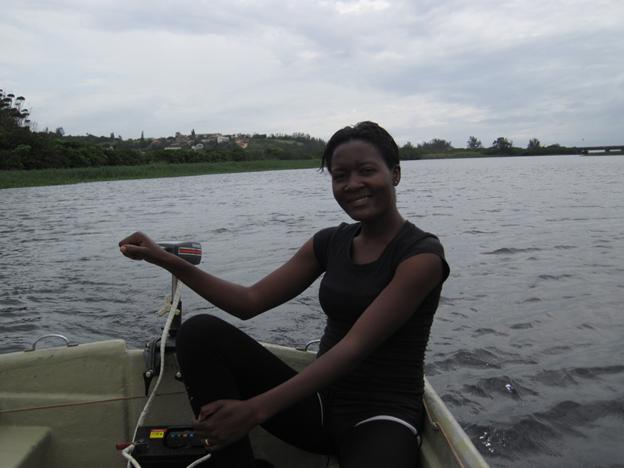Fru Azinwi Nche-Fambo
To understand the variability of microplankton community structure, laying emphases on nutrients, freshwater inflow, mouth opening events and water quality.

Sampling at the Mlalazi Estuary.
Phytoplankton are one of the main primary producers and health indicators in estuaries whose variation in community structure is influenced by environmental variables and in turn influence food web structure. Although 73 of South African estuaries are in KwaZulu-Natal province (KZN), little is known about their microplankton community structure and variability. Mlalazi and Mdloti estuaries of different ecological status will be investigated to understand the variability of microplankton community structure, laying emphases on nutrients, freshwater inflow, mouth opening events and water quality.
To determine microplankton community composition, subsurface microalgae samples will be collected biweekly (December 2014- December 2015) from four sites at Mlalazi estuary and three sites in the Mdloti estuary both north east of Durban, KZN, South Africa. Physico-chemical parameters (salinity, temperature, depth, dissolved oxygen and turbidity) will be measured with YSI 6920 multiprobe system. Size fraction chlorophyll a (Welschmeyer, 1994) and nutrients will be analysed (Mostert, 1983).
Water samples will be settled (Utermöhl, 1958), observed under the Nikon ECLIPSE Ti Series inverted microscope for identification, enumeration (Paxinos & Mitchell, 2000) and biovolume measurements (Hillebrand et al., 1999). Biovolume will then be converted to biomass (carbon) (Gosselain, 2000). To further investigate nutrients as drivers of community composition, cultures will be grown at different dilutions (0.2- 250µM) of F/2 Guillard’s (1975) nutrient media (NaNO3, NaH2PO4.H2O, Na2SiO3.9H2O) according to Creswell (2010) and subsamples analysed microscopically understand their variability with nutrients.
Multiple linear regressions will be conducted to assess the relationship between the physico- chemical and biological variables in attempt to understand the driving factors of microplankton community structure in KZN estuaries. Permutational Analysis of Variances (PERMANOVA) will be conducted to determine the differences between different treatments, sites and periods of sampling.
This study will lead to knowledge on microplankton community structure and biomass variability with respect to fresh water inflow and nutrients for both estuaries, better understanding of the changes in microplankton biodiversity, richness, abundance and biomass with mouth closing and opening events in TOCE’s laying emphasis on the duration of each event. Detail dinoflagellate species list and knowledge on potential harmful algal blooms will be documented. Since no comprehensive study has been conducted on microplankton community structure, the identification of the different taxa in the system will improve the knowledge on the state of the estuaries with regards to biodiversity, blooms and eutrophication by identifying certain taxa as estuarine water quality indicators which will be the first in South Africa.